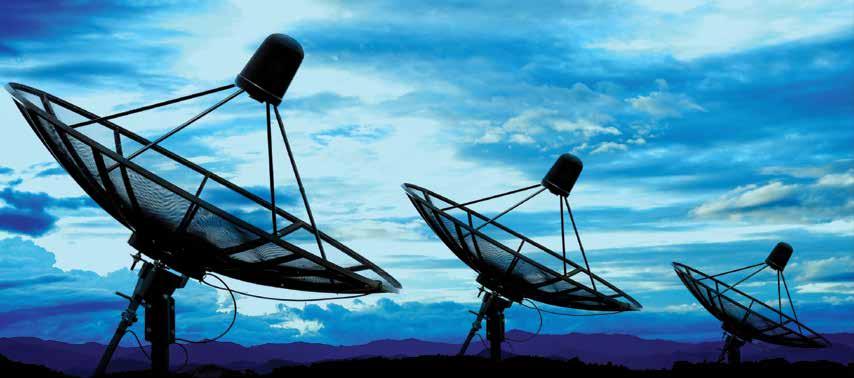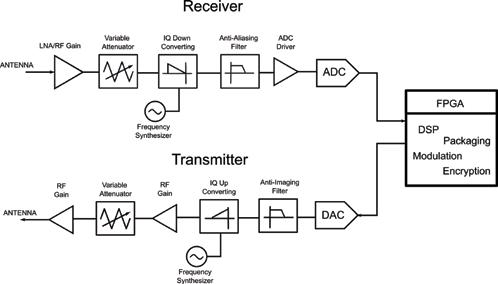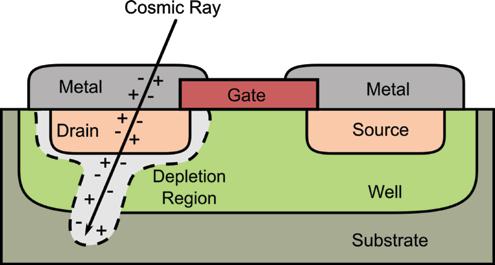
9 minute read
COTS in Space: Software Defined Radio (SDR) for Satellite Communication
by RTC Media
By Brandon Malatest, Founder, Per Vices Corporation
Introduction
One of the most critical devices in any satellite is the radio frequency (RF) communication module. It receives and transmits information that is used for receiving control from ground stations, sending status from onboard experiments and machine conditions, routing data packages for internet access, and navigation applications, such as GNSS/GPS. In modern satellites, almost all RF communication functions can be performed using a commercial off-the-shelf (COTS) system. In this context, software-defined radios (SDRs) are the best choice for COTS radio systems, given the variety of size, weight, and power (SWaP) options in the market. However, not all COTS SDRs are suitable for satellite applications, as they have to withstand the harsh conditions of space, such as drastic temperature fluctuations and intense ionizing radiation.
In this article, we will discuss the role of COTS SDRs in satellite systems, the main advantages of their use in onboard applications, and why they are the perfect choice for the job. Furthermore, it is crucial to take into consideration the impact of the harsh space environment on the analog and digital components of the SDR, so we will also discuss how satellite based SDRs require specific types of RF components to withstand the space conditions and work reliably.
What is SDR?
Before we can discuss anything related to the space applications of SDRs, we need to properly define an SDR. Software-defined radios are the product of a paradigm shift in radio technology that pushed most of the communication functions and signal processing to the digital realm, leaving only the essential RF signaling int the analog circuitry. Thus, SDRs are composed of three main blocks: the radio front-end (RFE), the digital backend, and the mixed signal interface (Figure 1). The RFE is the analog portion of the SDR responsible for the receive (Rx) and transmit (Tx) functions, used to receive the signals over a wide tuning range of 0 to 18 GHz, and in state-of-the-art technology this can be upgraded to 40 GHz. Moreover, the highest-bandwidth SDRs in the market can reach up to 3 GHz of instantaneous bandwidth per channel, with MIMO operation offering several channels in one RFE. The RFE is also responsible for filtering, amplification, and impedance matching. The digital backend, on the other hand, is responsible for performing most of the signal processing functions (such as DSP algorithms, modulation/demodulation, upconverting, and down-converting) and communication functions, including the radio protocols, artificial intelligence (AI) algorithms, and packetization. The digital backend typically consists of a high-performance FPGA with onboard DSP capabilities. Finally, the mixed-signals interface performs the connection between the RFE and the FPGA, and it is composed of multiple channels of ADCs and DACs. Both backend and ADC/DACs require high synchronicity to work properly, so a powerful time board is crucial. The implementation in high-end SDRs consists of an oven-controlled crystal oscillator (OCXO), that provides a stable (5 parts/billion) and accurate 10 MHz signal for clock, with low noise floor and phase noise.
One fundamental aspect of satellite electronics are that they are designed for worst case scenarios, as hardware replacements, maintenance, and adjustments are, almost always, impractical. This makes the design significantly expensive and overcomplicated. Moreover, the space conditions are highly variable due to the atmospheric and ionospheric effects, particularly in Low Earth Orbit (LEO)

One fundamental aspect of satellite electronics are that they are One fundamental aspect of satellite electronics are that they are designed for worst case scenarios, as hardware replacements, designed for worst case scenarios, as hardware replacements, maintenance, and adjustments are, almost always, impractical. maintenance, and adjustments are, almost always, impractical.

applications, so the “worst-case design” does not provide optimal channel performance. Therefore, satellite applications cannot rely on fixed designs based on hardware, as they require on-the-fly adaptation of the communication parameters. This flexibility is easily provided by SDRs, where the modulation, carrier frequency, power modes, the signal processing functions, and even the communication protocol can be modified without any hardware change. Moreover, the digital nature of the SDR provides much more robustness over different environmental conditions, which is crucial in space. Onboard SDRs are widely used in data transfer, navigation, and, ground-based tracking, telemetry, and control (TT&C).
However, onboard SDRs need to meet several requirements for satellite applications. First, the SWaP is crucial: there is limited space and power inside the satellite, and any increase in weight can significantly impact the launching. So compact and light devices with low-power modes are required. Furthermore, the device must also be designed to endure the high temperature variations of space and the intense forces and temperatures of the launching process (i.e. extreme thrust/gravitational forces and vibrational motion during launch, as well as temperature ranges depending on various factors including sun exposure and orbit type). It also needs to withstand ionizing radiation and solar storms, so the enclosure must be radiation hardened to avoid damages in the electronics. This is because the high-energy particles have a cumulative effect on the semiconductor, and the Total Ionizing Dose (TID) is an important parameter to measure the impact. For instance, the storage capacity of charge-based memory modules, including NAND, Flash, and DRAM, can be significantly affected by the TID, because of the defects caused in the silicon dioxide (SiO2) layers. Finally, the RFE must provide enough signal flexibility to adapt the RF communication to the highly variable atmospheric effects, including scattering, reflection, and refraction.
Even when radiation protection is implemented, high energy particles coming from the solar events can penetrate the shields and reach the electronic components of the satellites. In critical events, the interaction between the particles and the silicon from the electronics can be disastrous for the communication module. For instance, the Galaxy 15 spacecraft (a GEO satellite) was submitted to a solar anomaly on 5 April 2010, that caused an electrostatic discharge (ESD) on the digital backend circuitry, resulting in a failure in the communication with the ground station. The station regained control over the satellite again only at December 2010, after resetting the Baseband Equipment Command Unit. The Galaxy 15 case can be classified as a Single Event Effect (SEE). Different from the TID, SEEs are caused by single particles (high energy protons and cosmic rays) with enough energy to impact the device functionality. Semiconductor-based electronics are particularly prone to suffer from SEE, so exposed electronic parts must be protected with proper shielding. Figure 2 shows the effect of a SEE cosmic ray in the depletion region of a simple MOSFET.
To evaluate if the SDR is ready to withstand the orbital environment, a space qualification assessment must be performed. For satellite onboard components, the space-qualification process is divided in four domains: mechanical, thermal, electro-magnetic, and lifetime qualifications. The mechanical one verifies vibration and shock endurance, to check if the device can withstand launching and release conditions. The thermal test verifies if the device can endure wide variations in temperature in a controlled vacuum. The electro-magnetic qualification basically verifies the EMI and EMC performance of the device, to evaluate how compatible it is with the rest of the satellite equipment. The lifetime verification estimates how long the device will be operational, or how many cycles of a task it can perform without failure. Furthermore, parts screening and material analysis must be performed to ensure that the devices are adequate for space. Radiation hardening techniques can significantly improve the robustness of the device: Silicon on Insulator (SOI) substrates can eliminate the latch-up events, and package shielding can reduce the radiation exposure significantly. The hardening can also be obtained through software, by using error correction, redundant digital blocks, failure detection algorithms, hardened latches, and watchdog timer/reset.
Applications of SDRs in Space
Now that we covered the basics of SDRs and how they can be designed to comply with onboard satellites, let us can discuss some of the main COTS SDR applications for space systems. One basic example is in satellite sensing, especially in atmospheric monitoring applications. In these cases, the satellite is loaded with several sensors, which readings are then digitized and transmitted using an SDR. The SDR provides functions such as channel commutation, data packetization, and signal modulation. The onboard processor of the SDR can be even used to perform signal processing on the readings. COTS SDRs can also be used in ground stations to manage atmospheric data coming from space, providing flexible demodulation

Figure 2: Effects of SEE in a MOSFET transistor.
schemes and embedded intelligence to decode signals transmitted by different satellites.
Nanosatellites, also called cubesats (due to the typical cubic geometry), are becoming extremely popular in the space community. They are desirable due to the lower building cost, reduced design and manufacturing time, and easier launching processes, that allows many satellites to be launched into orbit with only one rocket. These advantages attracted small companies and universities to join the space development community, rapidly increasing the knowledge base for space electronics. COTS SDRs are highly popular in cubesats, as their compact SWaP allows easy implementation and integration in the small volume. Moreover, the flexibility provided by the FPGA gives the cubesats the ability to perform on-orbit upgrades, by simply uploading the up-todate version of the software. Furthermore, the communication module in cubesats must be significantly efficient, to account for the small power availability and bandwidth restrictions. Therefore, COTS SDRs are a perfect choice for small satellites, due to its flexibility and the variety of SWaP options in the market.
Finally, COTS SDRs present advantages that are desirable in basically any type of satellite application. Firstly, the flexibility provided by the FPGA gives the satellite the ability to use multiple modulation schemes in a single device, including AM, FM, FSK, ASK, and QAM. This increases greatly the application range of the satellite. Moreover, by changing the modulation scheme and carrier frequency, the satellite can easily adapt to environmental conditions, including atmospheric and ionospheric effects, maximizing channel capacity without losing the robustness and reliability of “worstcase scenario” design. The FPGA can also performs encryption/decryption algorithms for both uplink and downlink communication, which is fundamental in military applications. Satellites using COTS SDRs can also be reconfigured on-the-fly, eliminating the need for complicated and costly upgrades in loco. Finally, SDRs can significantly reduce the complexity of the radio system, by incorporating basically all signal processing blocks into one single module.
Conclusion
SDRs are able to significantly improve the flexibility and adaptability of a radio system, by incorporating almost all signal processing functions into the digital domain. They can also be easily obtained as COTS products, reducing the design cost and time. In the satellite industry, SDRs are the best choice for the communication system, providing the robustness, adaptability, and performance required. Moreover, the large variety of SWaP makes them suitable for any application, from large GEO communication satellites to cubesats used in space research. However, satellite systems require SDRs that are space-qualified for onboard operations, as the harsh space environment can easily damage the electronics and jeopardize the mission. Nonetheless, techniques such as radiation hardening and shielding can be easily applied in SDRs, so space qualified COTS are available in the market.
About Us
Per Vices has extensive experience in designing, developing, building, and integrating SDRs for space-based and ground station applications. Contact solutions@pervices.com today to see how we can help you with your SDR needs.


